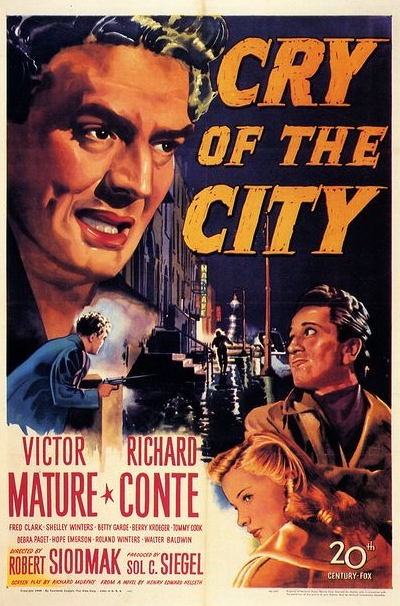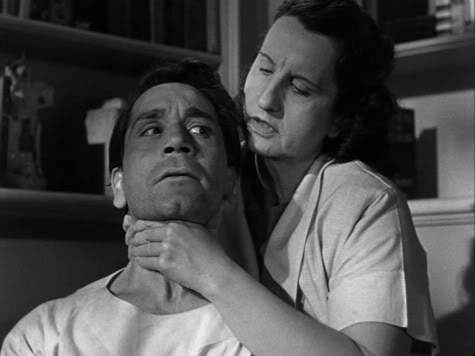
He’s out there somewhere…in an alley, on a roof…looking for a way out.
One of the most interesting, and the most enjoyable, aspects of the best noir pictures is the blurring of the lines between the hero and the villain. In a way, the noir world doesn’t have any real heroes, just people forced to make the best of whatever circumstances life pitches at them. Characters may be stylised, situations may be exaggerated, but the dilemmas and bad breaks that have to be faced are issues that most people can identify with on some level. I think it’s this ambiguity that ensures the enduring popularity of these films. While fashions, speech patterns and social attitudes are obviously changing all the time, human nature remains constant. Robert Siodmak’s Cry of the City (1948) is a classic manhunt thriller that toys with the viewer’s sympathy by presenting both hunter and hunted as two sides of the same coin.
Martin Rome (Richard Conte) is an Italian American hood who’s just taken one chance too many. A botched hold-up has left a policeman dead and Rome badly wounded and clinging to life. As his family and priest gather at his bedside to pray for him, the law in the shape of Lt. Candella (Victor Mature) hovers in the wings, waiting to hand down retribution. Rome is a doomed man, his killing of a cop can have only one outcome. But doomed men can be of value to desperate men, and so the vultures circle. With the knowledge that Rome has no future, crooked lawyer Niles (Berry Kroeger) tries to coax him into confessing to a murder that would let his client off the hook. When this approach doesn’t meet with any success, Niles makes the mistake of threatening Rome’s girl, Teena Riconti (Debra Paget). Now, he has a reason to live; both the police and Niles want to get their hands on Teena for their own ends. Rome needs to get out of the prison hospital, track down Niles and his accomplices, protect Teena, and try to make good his escape. All the while he’s dogged by his nemesis, the tenacious Candella, a man who seems to be on a personal crusade to run him to ground. As Rome runs and Candella pursues him, we get to see the contrasts and similarities between the two men. Both come from essentially the same background, namely poor immigrant families, but both have chosen different paths out of the urban squalor. Candella walks with the righteous, but the face of the law he presents is a rigid and largely inflexible one. He shows no mercy in his dealings with all the little people who offered assistance to the fugitive, promising instead only prosecution and punishment. As such, it is notable that Candella never receives any willing help whereas Rome has no shortage of people prepared to go the extra mile for him, albeit for their own reasons. Also, when Rome lay wounded in hospital he was surrounded by family and friends, but when Candella later suffers a similar fate his only visitor is his partner.
Richard Conte’s smooth talking gangster is a fine performance. You know he’s no good but can’t help rooting for him. The fact that he gets to deliver the best lines of the script and enjoys the lion’s share of screen time is helpful of course. It’s also significant that the killing for which he’s originally wanted is never shown and is only referred to briefly. When he does off someone on screen, that character is such an unpleasant slimeball that you feel he’s justified in doing so. Victor Mature’s persistent detective, on the other hand, is hard to like. He plays a cold, judgmental man with only a trace of humanity; the scenes where he visits Rome’s family are where he comes off best, yet even there his sincerity is open to question. It’s not really any surprise that his character has doors slammed in his face where Conte has them opened invitingly to him. The supporting cast is excellent, although the real stand out is Hope Emerson. This imposing figure of a woman is a genuinely unnerving presence, and you feel she could crush Conte’s ailing Rome just for the sadistic pleasure of it.

Robert Siodmak made a lot of noir pictures, and I don’t believe any of them were poor. Cry of the City may not be his very best but it’s not far off. There are some beautifully framed shots on view, not the least of which is the final showdown between the two protagonists. He also handles the more suspenseful passages, such as Rome’s brazen escape from the hospital with a deft touch and excellent camera placement. The whole film exudes the noir atmosphere with plenty of wet sidewalks, flashing neon and wailing police sirens. I think what helps the film succeed the most is the inclusion of all the incidental characters and situations, from the Rome’s apartment with the Amercan and Italian flags hanging side by side above the mantle to the frightened immigrant doctor who’s willing to risk imprisonment to find the cash to care for his sick wife. I can’t help seeing some parallels between this film and Carol Reed’s Odd Man Out in terms of theme and narrative structure, although Conte never achieves the level of pathos seen in James Mason’s dead man walking. I’d also like to mention the great score by Alfred Newman; this music was used on a number of occasions in Fox movies but its melancholy notes are the ideal accompaniment to this fatalistic production.
Cry of the City is available on DVD in a number of editions in R2. I have the German release, and I understand it’s the pick of the bunch. It was previously only possible to buy this in combination with Sam Fuller’s House of Bamboo but it is now available in a stand alone edition. I couldn’t see anything wrong with the transfer which has very good contrast, is sharp, and displays next to nothing in the way of damage. There have been rumours for some time of this title getting the Criterion treatment but, at the time of writing, it still remains absent in R1. I’m not sure why Fox never went ahead and released this as part of their own noir line and, given recent reports of personnel changes taking place in their home video division, it remains to be seen what will be forthcoming from them in the future. Anyway, I give Cry of the City a big thumbs up, it’s an excellent film noir from a director at the top of his form.
What can I say. One of my dad’s favorites. The ending is great.
LikeLike
Thanks for the comment.
I think the ending’s great too…and the middle…and the beginning… 🙂
LikeLike
Great review and great film! Now that its finally getting its R1 release — in the cursed MOD format, unfortunately — I thought I’d check your archives and reminisce. Excellent as usual!
LikeLike
I don’t know why such an excellent film took so long to come out in the US. It is a genuine film noir and would have been an ideal inclusion in the Fox Noir line back when that was still up and running.
LikeLike
Pingback: Little Red Monkey | Riding the High Country
The first time I saw this I was rather disappointed with it. The second time I came away liking it a lot more. LOL Must of had a few too many cold ones first time around. As you point out, Conte shines here. Good write-up.
LikeLiked by 1 person
I reckon we should never underestimate our mood, and how it affects our perceptions, when we’re viewing things. I also wonder whether crime and/or noir films are more susceptible to this phenomenon – a lot of stuff has worked better for me second time round, sometimes because I was concentrating so hard on unraveling the plot initially, or because I hadn’t adjusted to or “got” the vibe being tapped into.
LikeLike
Pingback: Deported | Riding the High Country
Pingback: Ten of the Best – Women of the West | Riding the High Country